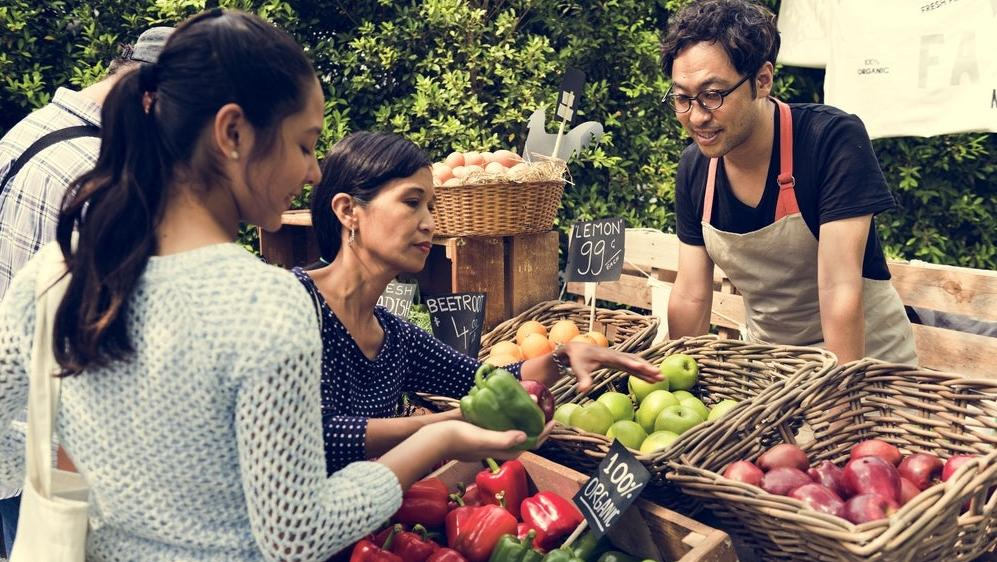How Farms Decide Which Vegetables To Bring To Market
Choosing what to grow is a more complicated decision than you might think.
If you can't find red cherry tomatoes—or zucchini, or tomatillos—at your local farmers market this year, it's probably not because the crops failed. Not entirely, anyway.
While seasonal gems like watermelon, peaches, and corn might seem to materialize spontaneously at markets across the country come July and August, everything you see for sale at the market is the end result of careful planning. With a business as precarious as a small farm, time, labor, and market space are all precious resources, and things aren't getting any easier: pandemic-related supply issues, the impacts of climate change, and fuel cost inflation are eating into farmers' bottom lines as well. So, given all these constraints, how does a farmer succeed?
Farm labor varies by vegetable
For Tricia Bross, owner of Luna Circle Farm in Rio, Wisconsin (roughly 30 miles northeast of Madison), one of the unfortunate casualties of the last couple of years has been squash. Zucchini in particular, Bross explained, is one of the more labor-intensive vegetables to grow, and when the pandemic rolled around Bross wasn't sure if she'd have consistent labor to harvest the zucchini that year.
"We didn't miss them financially," said Bross. So, she decided to cut them for good.
How pests impact produce
Environmental factors can inform these decisions as well. Pest pressure—a serious side effect of climate change—also impacts what Bross chooses to grow.
"We've got bugs that used to stop in, like, Missouri, and they now make it to the upper Midwest," she said. Those bugs, called squash bugs, can render an otherwise perfectly good-looking winter squash unusable. "You open it up and it's rotten inside." It wasn't worth the risk, so Bross decided to cut winter squash completely.
Farms know what consumers want
One approach shared among farmers, perhaps unsurprisingly, is that they don't grow what doesn't sell.
Sometimes, farmers are forced to eliminate items because they simply can't sell enough of them to justify the cost of producing them. Ana Barajas, manager of Barajas Produce, a family-owned farm in Montross, Virginia, said over the phone that they've had to completely stop production of shishito peppers this year.
"It was really hard for us to move [them]," Barajas said.
If an item like shishito peppers isn't moving quickly enough at the market, Barajas explained, the business will make a note of it for when it's time to place seed orders in December and January.
"We pretty much have to know by the end of November what varieties did work, and what did not work," said Barajas.
But deciding what to grow—and how much of it to grow—is often still more complicated than that. Barajas Produce, which sells at markets across the DC area, from Fredericksburg, Virginia to Silver Spring, Maryland, encounters different levels of demand for certain items depending on location.
In Arlington, for example, customers gravitate toward a certain variety of cherry tomato over others. Those numbers will factor into how much of each item the farm chooses to plant, Barajas explained. Tomatillos, as well as peppers like jalapeños, are also a particularly hard sell in DC; Barajas said that they'll try to sell more of those through their wholesale channels rather than at markets.
Farmers might even choose to bring less of an item to market if it hasn't sold well the previous weeks—even if it's ready to pick.
"We're always watching our numbers of what we sold the week before," said Joe Schirmer, who owns Dirty Girl Produce in Santa Cruz County, California. If something hasn't sold well, he'll often just leave it on the vine. "To pick something that we don't sell at the market is a waste of everybody's time and money, you know?"
Just as a busy restaurant might calculate the number of seatings they'd have to do in a night in order to turn a profit, farmers are often trying to maximize every square foot of space available in their stall. If a product isn't selling well enough, it's not just a waste of time and labor, but can also be a major opportunity cost.
"I only have 700 square feet of space, so I can't put something out there that's not going to hold its weight," said Eli Cook, co-owner of Spring Valley Farm and Orchard in Augusta, West Virginia.
If a farmer has an overabundance of something, like peak-season tomatoes, it's not necessarily as simple as dropping the price in an effort to incentivize more people to buy it; in that case, explained Schirmer, "you just did twice as much work for the same amount of money."
The next time you drop by your local farmers market, keep in mind that everything you see was selected and grown deliberately by the farmers you purchase from—so try to savor what's there, and if one of your favorites is missing, you might have a better idea of where it went and why.
